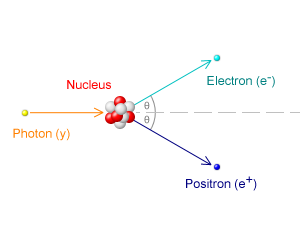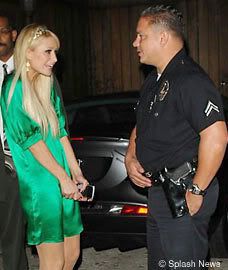
Are we talking about pair production?
Posted on 03/07/2010 2:11:48 PM PST by LibWhacker
Cutting the threads of the spacetime fabric and reinstating the aether could lead to a theory of quantum gravity.
If there’s one thing Einstein taught us, it’s that time is relative. But physicist Petr Hořava is challenging this notion and tearing through the fabric of spacetime in his quest for a theory of quantum gravity. His work may also resurrect another entity that Einstein had seemingly buried—the aether.
Physicists have spent decades searching for a way to reconcile the seemingly incongruous twin foundations of modern physics: quantum theory, which deals with the infinitesimally small, and Einstein’s theory of gravity, general relativity, which deals with the vast cosmos. This effort has led to a dazzling array of candidate theories—including superstring theory, loop quantum gravity, and doubly special relativity—but none have succeeded in unambiguously bridging the quantum-gravity divide. The problem: When you try to do the math to work out the strength of forces on the quantum-gravitational scale, your calculations return a maddening proliferation of infinite answers that have no physical meaning.
Now Hořava, at the University of California, Berkeley, claims to have found a solution that is both simple and—in physics terms, at least—sacrilegious. To make the two theories gel, he argues, you need to throw out Einstein’s tenet that time is always relative, never absolute.
Hořava’s controversial idea is based on the fact that the description of space and time in the quantum and relativistic worlds are in conflict. Quantum theory harks back to the Newtonian concept that time is absolute—an impassive backdrop against which events take place. In contrast, general relativity tells us that space and time are fundamentally intertwined; two events can only be marked relative to one another, and not relative to an absolute background clock. Einstein’s subjective notion of time is well accepted and is the hallmark of Lorentz invariance, the property that lies at the heart of general relativity.
"Lorentz invariance is not actually fundamental to a theory of quantum gravity," says Hořava. "But the problem so far has been that many cosmologists are wedded to the concept."
Good Gravitons
By restoring the absolute nature of time at very high energies, such as those in the early universe where quantum gravity would be important, Hořava can treat variations in space and time differently. The upshot of this is that in your calculations at very short distances you do not get such dramatic spatial variations as you do in general relativity, taming the infinities that frustrate other candidate theories of quantum gravity. This makes it possible to describe gravity on the quantum level using a well-behaved graviton—the hypothesized quantum particle thought to mediate gravity, just as the photon mediates the electromagnetic force (arxiv.org/abs/0901.3775).
So far Hořava’s potential resolution of a decades-long physics stalemate has been creating a buzz. Last year, five of the top ten cited academic papers in high energy physics dealt in some form with Hořava’s model.
"The existence of an absolute time might ensure that the usual framework of quantum mechanics can survive even the most exotic regimes of quantum gravity," says physicist Ted Jacobson at the University of Maryland, College Park.
Surprisingly, Hořava’s trick is fairly commonplace in the laboratory. Condensed matter scientists looking at complex real-world systems, such as superconductors at low temperatures, have been using the idea that space and time are not on the same footing for years. Cosmologists do not usually take the lead from their condensed-matter cousins because of "sociological barriers," but the groups should look to each other for inspiration more often, says Hořava. He borrowed ideas from condensed matter models when developing his theory of quantum gravity. "In some condensed matter systems, relativistic behaviour and Lorentz invariance only emerge at lower energies," he says.
But while condensed matter physicists have shown that their models can recover relativistic behaviour as required at low energies, the big question is whether Hořava gravity can successfully morph back into the classical theory of relativity, in a way that agrees with all observations. In principle, general relativity should emerge at lower energies and larger distances. In other words: Look at a patch of the universe with infinitely powerful glasses and you would see that time and space are distinct from one another. Zoom out and the picture blurs, restoring Einstein’s more familiar spacetime fabric.
Knife-Edge
There is some support that this emergence does indeed happen from computer simulations of quantum gravity carried out by Jan Ambjørn of the Niels Bohr Institute at the University of Copenhagen and his colleagues. Ambjørn’s simulations showed that at short distances, the familiar four-dimensional spacetime of our macroscopic universe seems to shrink to just two dimensions—one space and one time. Hořava believes that his theory can explain how those spatial dimensions disappeared.
According to Hořava, this vanishing point marks the knife-edge at which general relativity breaks down and his theory of gravity comes into play. As the fabric of spacetime rips, space and time start to stretch at different rates. The stronger constraints on short distance spatial variations mean that space now stretches only a third as quickly as time, effectively reducing the familiar three spatial dimensions into just one.
Since Hořava first proposed his theory in 2009, other researchers have used it to answer important cosmic questions about the nature of the Big Bang, dark matter and dark energy. Jacobson, however, feels there is much work still to be done before the theory can be widely accepted. "Hořava’s paper triggered a feeding frenzy, but most workers outside that frenzy remained wisely sceptical," he says.
Gustavo Niz at the University of Nottingham, UK, notes that physicists have found that in its original form, Hořava theory has plenty of "pathologies" and does not recover general relativity. "However, the idea behind the model is encouraging and scientists have ideas on how to cure all these secondary problems," he says.
Among those attempting to fix the original model are Diego Blas and Sergei Sibiryakov at the Swiss Federal Institute of Technology (EPFL) in Lausanne, and Oriol Pujolas at CERN near Geneva. Their work has revealed a flaw in the model: Minor variations in the initial conditions used in calculations in Hořava gravity can give dramatically different results (arxiv.org/abs/0909.3525). The culprit is a unique and unstable "breathing mode" in which space can locally expand or contract, wreaking havoc with your answers. To address this problem, they’ve modified Hořava’s initial proposal, making it harder for this breathing mode to develop. They have dubbed their formulation "extended Hořava gravity."
“In my view, the extended version of Hořava gravity is the only currently viable approach and needs to be extensively analysed,” says Jacobson.
Einstein’s Aether?
Jacobson’s own current research, funded by FQXi, examines the short distance structure of space and the quantum vacuum as space expands. He is also now looking at connections between Hořava gravity and an earlier modification of relativity, dubbed "Einstein-aether theory" that he had proposed a decade back.
Nineteenth-century physicists believed light waves must move through an "aether"—a medium that permeates all of space, allowing light to propagate just as sound waves move through air. However, a series experiments by Michelson and Morley failed to find any evidence that Earth moves through an aether. Einstein’s theory of relativity was the final nail in the aether’s coffin, because it explained that light moves through a vacuum.
Jacobson does not believe that the nineteenth-century aether exists. However, within Einstein-aether theory—in contrast to general relativity—there is a preferred time that can be used as an absolute reference to mark events against. It is as if spacetime were filled with a fluid—an aether—which defines a "rest frame" at each event.
Like Horava’s theory, Einstein-aether theory breaks Lorentz invariance and may lead to a viable mechanism for producing gravitons. To get from the general Einstein-aether theory to extended Horava gravity, you simply assume that the aether rest frame arises from an absolute time.
Jacobson has shown that some of the tests proposed to confirm or rule out Einstein-aether theory over the years could also falsify Hořava gravity (http://arxiv.org/abs/1001.4823). "The list of potential experimental signatures includes everything gravitational: from modified orbits to gravitational radiation—there is a new type of gravity wave in Hořava theory from the breathing mode—to the structure of neutron stars and black holes, and perhaps even more exotic stuff," says Jacobson.
For now though, Hořava remains modest, and is glad that others are examining his work. "My papers present the basic idea but don’t present a full theory yet," he says. "It is still unclear which of the possible different trajectories is best."
The computed necessary speed for a sub-electron particle would get you to one of the near galaxies in a couple of seconds. That leads to all kinds of interesting things, try linking to the link I provided above and download the PDF book file.

Are we talking about pair production?
What’s going on here? What’s with these deniers? This is “settled science” and as such is immune from criticism.
The worst moment for the atheist is when he is really thankful and has nobody to thank.
-Dante Gabriel Rossetti
http://mysite.verizon.net/r9ns/
The item you want is that first item about gravity and magnetism.
Money quote:
The implications of this simple mechanism are many.
There's your mistake. That's like saying "assuming light is infinitely fast..." - well, it isn't. The movement on the bar must propagate from one end to the other (as information if nothing else), which cannot propagate faster than light.
My gut reaction is that this guy is somehow declaring X=Y, then going thru convolutions to achieve the startling discovery that X=Y.
I’ll grant that there’s probably more to Relativity than Einstein described, much as there is more to physics than Newton described. Nothing discovered in science has, so far, proven complete.
Care to elaborate? Link?
Now, given such impossible contradictions as an indicator one does not adequately understand the issue, it is fun to re-approach the illustration with what IS known and determine what the consequences are. To wit:
One cannot assume incompressibility as a “push” amounts to a wave function manifest as sound propagating thru the bar; for the bar to be incompressible the speed of sound in the material would be infinite - which is absurd. HOWEVER, if we consider that the speed of sound within the bar cannot exceed the speed of light (a mathematically proven notion which is holding up when subject to reality), we could calculate a “maximum (minimum?) compressibility” for any physical substance. Give your 200 million mile long bar a kick, assume the impulse travels at the speed of light, and you can calculate how hard (i.e.: incompressible) your bar actually is (computation is left as an exercise to the reader).
In HS physics I once applied the same notion to heat: as heat is the movement of atoms, and atoms cannot move faster than the speed of light, I worked out what the universal “maximum temperature” is (pity, I can’t seem to find that calculation again; it was large but not staggeringly so), concluding that the temperature scale is in fact finite, with an “absolute hot” to match “absolute zero (cold)”.
In High School I watched the 'Dukes of Hazard' every week.
Hmm ... somehow I doubt doing so involved calculating ballistic trajectories of the General Lee.
Yes, I was that much of a geek. (Chemistry class involved much time studying exothermic reactions.)
Thank you for the link. As a pre-K amateur in all this stuff, it looked to me like something was wrong after I read the first book—The Big Bank Never Happened. I hope I live long enough for humans to have some better idea about these things. But it will probably be another couple a hundred years at least. By then, I will already know.
parsy, whose first trip in Heaven is to the Bookstore in the Sky
Thank you! I was close—only two letters away. Maybe it’s DYSON(?) I was thinking about. Then there’s the 3 letter guys. RPG, KRA, something like that. I’m stuck in the bedroom for a while, and all my books are either out back, or in storage, or elsewhere.
I seem to recall reading there was a possible mathematical boo-boo in either Feynman or somebody that had never been followed up on due to the adherence to Copenhagen influence.I guess I could google “mathematical boo boo quantum physics”, but if it was successful, I’d be there for days reading those new experiments that Indian guy is doing on Heisenburg/Schroeder quantum stuff-—spooky action at a distance. That stuff just fascinates me.
parsy, who apologizes for his brain infarcts
Care to elaborate? Link?
Metaresearch site article on actual experiments involving the speed of gravity propagation.
I got your Uncertainty Principle right here...
Don't confuse Mars candies ("melts in your mouth, not in your hand") with Bob Dylan.
Or the Weathermen / SDS.
We don't want any Ayers acolytes around here during the Obama administration, thank you very much.
Now, if you want to hear about the double-slit experiment, it concerns Rita Hayworth and Sophia Loren, both wearing a certain type of dress....I'd tell you more, but as it involves hardons in degenerate modes and simple hormonic motion, you'll have to sign a release that you're over 18.
Cheers!

 ">
">

 ">
">
 ">
">
Cheers!
Okay, maybe providing you that link did not raise the level of discourse over here. Until you arrived I had anchor man of the class locked up.
They integrated from the very point of origin. Her curves were continuous, and even though he was odd, he was a real number. The day their lines first intersected, they became an ordered pair. From then on it was a continuous function. They were both in their prime, so in next to no time they were horizontal and parallel. She was awed by the magnitude of his perpendicular line, and he was amazed by her conical projections. “Bisect my angle!” she postulated each time she reached her local maximum. He taught her the chain rule as she implicitly defined the amplitude of his simple harmonic motion. They underwent multiple rotations of their axes, until at last they reached the vertex, the critical point, their finite limit. After that they slept like logs. Later she found him taking a right-handed limit, that was a problem, because it was an improper form. He meanwhile had realized that she was irrational, not to mention square. She approached her ex, so they diverged.
Disclaimer: Opinions posted on Free Republic are those of the individual posters and do not necessarily represent the opinion of Free Republic or its management. All materials posted herein are protected by copyright law and the exemption for fair use of copyrighted works.